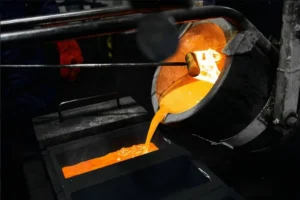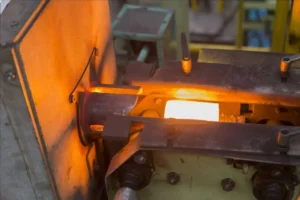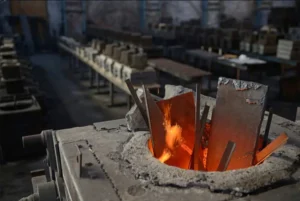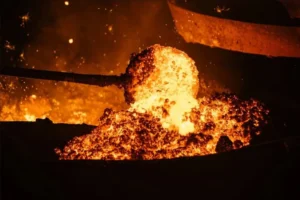Lò nung cảm ứng là thiết bị quan trọng trong ngành nấu chảy kim loại, Cung cấp quyền kiểm soát vượt trội trong quá trình sưởi ấm so với các loại lò khác. Tuy nhiên, để duy trì hiệu quả của nó và kéo dài tuổi thọ của nó, Bảo trì hàng ngày là điều cần thiết. Liệu lò nung cảm ứng của bạn có được sử dụng trong một xưởng đúc, hoạt động luyện kim, hoặc bất kỳ môi trường kim loại công nghiệp nào, Chăm sóc đúng cách các thiết bị quan trọng này là cần thiết để ngăn chặn thời gian chết, Cải thiện an toàn hoạt động, và giảm chi phí sửa chữa.
Trong blog này, Chúng tôi sẽ phác thảo các nhiệm vụ bảo trì hàng ngày thiết yếu cho một lò nung cảm ứng và cung cấp các mẹo thực tế để giữ cho lò của bạn trong điều kiện tối ưu.
Kiểm tra các thành phần điện và kết nối
Trái tim của một lò nung cảm ứng là hệ thống điện của nó, trong đó bao gồm nguồn cung cấp điện, cuộn dây cảm ứng, và các thành phần kiểm soát. Bất kỳ sự cố nào trong các phần này đều có thể dẫn đến thời gian ngừng sản xuất đáng kể.
- Kiểm tra hệ thống cung cấp điện: Đảm bảo nguồn cung cấp ổn định và hoạt động. Tìm kiếm bất kỳ dấu hiệu khác thường của dao động điện áp hoặc bất thường trong bảng điều khiển.
- Kiểm tra kết nối điện: Thường xuyên kiểm tra các kết nối điện cho bất kỳ thiết bị đầu cuối hoặc dấu hiệu ăn mòn nào. Thắt chặt hoặc làm sạch chúng khi cần thiết để ngăn ngừa lỗi điện.
- Kiểm tra cuộn dây cảm ứng: Cuộn dây chịu nhiệt và ứng suất điện từ không đổi. Kiểm tra xem có dấu hiệu mòn nào, bẻ khóa, hoặc biến dạng. Nếu có bất kỳ thiệt hại nào được phát hiện, Nó nên được sửa chữa hoặc thay thế ngay lập tức.
Giám sát hệ thống làm mát
Hệ thống làm mát là không thể thiếu để duy trì nhiệt độ của các thành phần điện của lò, đặc biệt là cuộn cảm ứng và nguồn cung cấp điện. Nếu hệ thống làm mát không thành công, lò có thể quá nóng, dẫn đến thiệt hại.
- Kiểm tra chất làm mát cấp độ: Đảm bảo rằng chất làm mát ở mức được đề xuất, và nạp tiền nếu cần thiết. Theo thời gian, chất làm mát có thể bốc hơi hoặc bị ô nhiễm, giảm hiệu quả làm mát của nó.
- Kiểm tra các đường làm mát cho tắc nghẽn: Kiểm tra các ống làm mát cho bất kỳ tắc nghẽn nào, rò rỉ, hoặc vết nứt. Tắc nghẽn trong hệ thống có thể dẫn đến sự cố quá nóng và thất bại hệ thống tiềm năng.
- Kiểm tra máy bơm làm mát: Đảm bảo bơm làm mát hoạt động chính xác và lưu thông chất làm mát trong toàn bộ hệ thống. Một máy bơm bị trục trặc có thể khiến lò quá nóng, dẫn đến thiệt hại tiềm tàng.
Kiểm tra dư lượng kim loại và ô nhiễm
Dư lượng kim loại và tích tụ xỉ bên trong lò có thể ảnh hưởng tiêu cực đến hiệu suất của nó. Chúng có thể cản trở quá trình sưởi ấm, Giảm hiệu quả nóng chảy, và thậm chí làm hỏng cuộn cảm ứng.
- Loại bỏ dư lượng kim loại và xỉ: After each melt cycle, carefully clean the interior of the furnace, removing any slag or metal residues. Use appropriate tools such as scrapers or vacuum systems to avoid damaging internal components.
- Inspect furnace linings: Theo thời gian, the furnace lining can wear down due to constant exposure to heat. Inspect the linings for cracks, xói mòn, or pitting, and replace them if necessary.
Inspect and Clean the Furnace Doors
Furnace doors are exposed to extreme temperatures and need to be regularly checked for wear and damage.
- Check the sealing system: Ensure that the seals on the furnace doors are intact and functioning properly. A faulty seal can result in heat loss, lowering efficiency and increasing energy costs.
- Clean the door surfaces: Regularly clean the furnace doors to prevent the buildup of residue, which can impact the sealing or cause the door to become difficult to open and close.
Examine the Furnace’s Load and Vibration
The load on an induction furnace can affect its overall performance and longevity. Overloading can lead to overheating, while improper load distribution can cause excessive wear.
- Ensure proper load distribution: Verify that the furnace load is evenly distributed to avoid overheating and undue stress on the equipment.
- Monitor vibrations: Excessive vibration can signal alignment issues or problems with the induction coil. Use a vibration sensor to monitor the furnace’s operational stability and address any abnormal readings.
Check Safety Systems
Safety is paramount in any industrial setting. An induction furnace is equipped with various safety mechanisms to protect both the equipment and personnel from accidents.
- Test emergency shutdown systems: Ensure that emergency stop buttons and automatic shutdown systems are working properly in case of electrical faults, overheating, or other hazardous conditions.
- Inspect alarms and sensors: Test all safety alarms, including temperature, áp lực , and cooling system alarms, to ensure they are in working order. Malfunctioning sensors can lead to dangerous operating conditions.
Record Operational Data and Issues
Keeping a log of the furnace’s daily operational data is essential for tracking its health and performance. This record can help identify patterns or recurring issues, enabling proactive maintenance before they escalate into major problems.
- Track temperature and power usage: Record the furnace’s operating temperature, Tiêu thụ năng lượng, and any deviations from standard operating parameters. This data can provide insight into furnace efficiency and potential issues.
- Note any unusual behavior: Record any unusual noises, vibrations, or performance drops. These could be signs of underlying problems that need to be addressed.
Perform Routine Calibration
Theo thời gian, the furnace’s controls may drift, leading to inaccuracies in temperature regulation and power output. Routine calibration ensures that the furnace is operating at optimal settings.
- Calibrate temperature and power controls: Perform daily calibration checks to ensure that the furnace is maintaining accurate temperature settings and power levels. Use precision instruments to verify the furnace’s performance.
Phần kết luận: Keeping Your Induction Furnace in Top Shape
The daily maintenance of an induction furnace is essential to ensuring its longevity and reliable operation. By following these steps—checking electrical components, monitoring the cooling system, cleaning residue, inspecting doors, and maintaining safety systems—you can prevent costly repairs, minimize downtime, and enhance the overall efficiency of your furnace.
Nhớ, proactive maintenance is always more cost-effective than reactive repairs. By dedicating time to daily upkeep, you’re not only extending the life of your furnace but also improving the quality of the metal you’re processing, which translates into better results for your operations.







